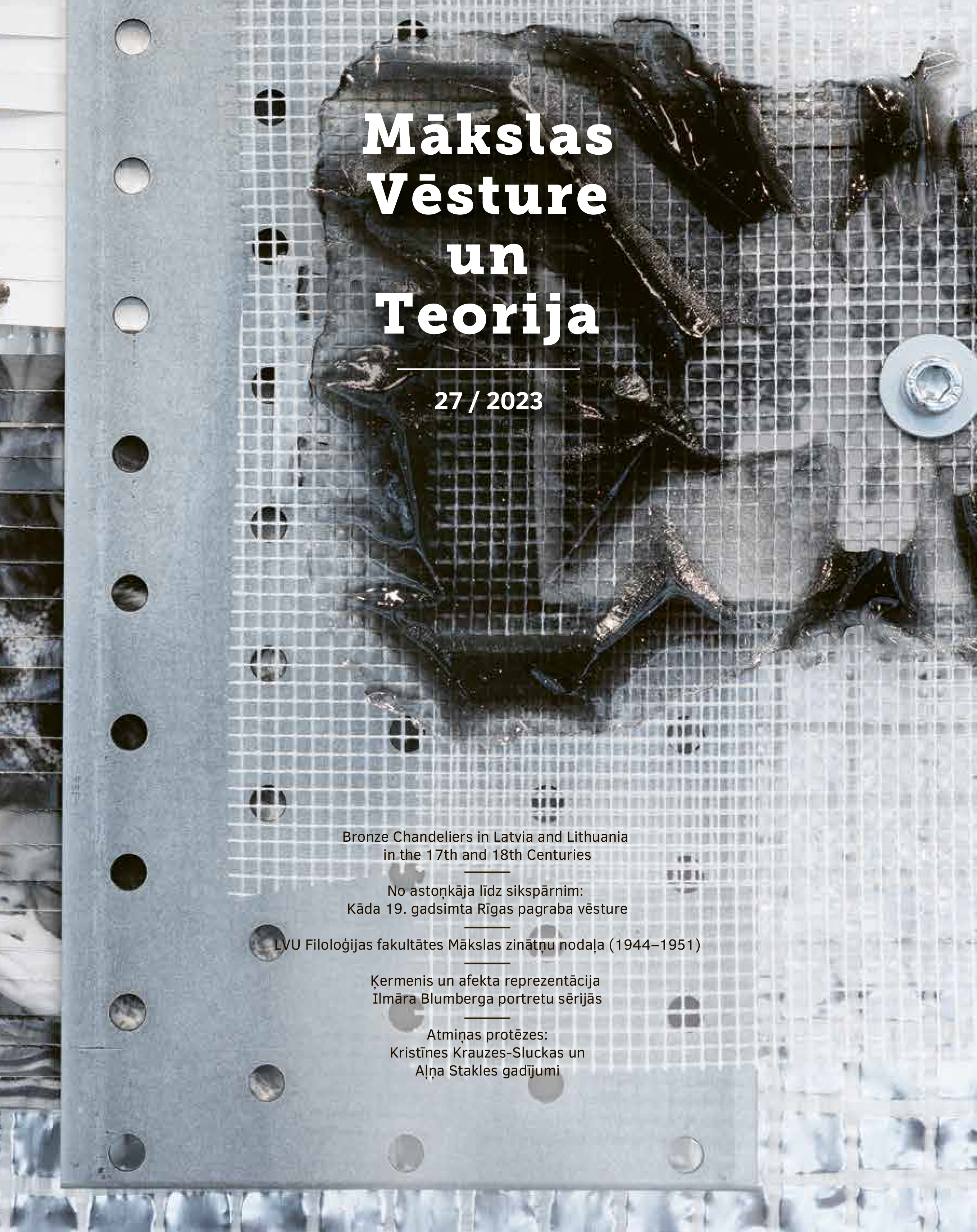Bronze Chandeliers in Latvia and Lithuania in the 17th and 18th Centuries. Manufacturing, Typology and Survival
Bronze Chandeliers in Latvia and Lithuania in the 17th and 18th Centuries. Manufacturing, Typology and Survival
Author(s): Alantė Valtaitė-GagačSubject(s): Cultural history, Architecture, Visual Arts, 17th Century, 18th Century, History of Art
Published by: Mākslas vēstures pētījumu atbalsta fonds
Keywords: Bronze chandeliers; applied arts; Lithuanian art; Latvian art; European chandeliers; stem chandeliers; bronze casting; Mannerist chandeliers; Baroque chandeliers;
Summary/Abstract: Bronze chandeliers play an important role in the development history of European chandeliers. The Netherlands, Belgium and Germany were their production centres from the 15th century. A type of stem chandelier with a large polished sphere at the terminal that appeared in the 17th century was so popular that it spread to the farthest corners of Europe and remained popular in some places until the late 18th century. The historical written sources testify that in the 17th century, bronze chandeliers were dominant in Lithuania’s sacral and probably secular interiors. Regrettably, only a dozen examples have survived to the present day and this number is too low to draw objective conclusions about their style and development trends. During numerous expeditions to Latvian churches, public interiors and museums, around 53 valuable bronze chandeliers from the late 16th – 18th centuries have been found. Accordingly, the study aimed to systematise the data about the bronze chandeliers in the 17th and 18th centuries that have been preserved in Latvia, to provide insights into their development and stylistic features and, based on these data, to perform a theoretical reconstruction of chandeliers that have not survived in Lithuania. The article briefly reviews the cultural and historical context of Latvia and Lithuania, the nuances of the production of bronze lihting devices and mainly focuses on the insights into the features of Lithuanian and Latvian bronze chandeliers. Vilnius in Lithuania and Riga in Latvia were the most important crafts centers. However, very little is known about the masters who cast chandeliers in Lithuania. Unlike Vilnius, Riga was a much more important centre for craftsmen. After reviewing the dictionary and a separate study on casters by Latvian historian Paul Campe, it can be said that 11 casters who made chandeliers worked in Riga from the late 16th to the 18th century. Unfortunately, chandeliers were rarely marked with the master's marks and only a few candlesticks and not a single chandelier are currently assigned to the listed masters. Discussing the features of hanging lighting devices, the bronze chandeliers in Lithuania and Latvia from the late 16th to the 18th century can be attributed to the stem type. These chandeliers have one main profiled stem to which arms are attached as the chandelier’s main and most important part. This type is generally the most common and well-known in Europe. Six Mannerist chandeliers are currently known in the Evangelical Lutheran churches in Durbe, Umurga, Nereta, Tukums, Saka (Sakasleja) and St John’s in Riga. The mentioned chandeliers were made in the late 16th through to the mid-17th. Their stems consist of many flat-shaped spheres and discs; the upper part is decorated with a double-headed eagle and the lower part with a lion’s head typical of Mannerist chandeliers. Mannerist chandeliers like those in Latvia have not survived, but according data in written sources could be used in Lithuania. However, we have a slightly different group of Mannerist chandeliers with serpent arms. Based on the analysis of the historians Berend Dubbe and Frans van Molle, we can state that the motif of the elegantly coiled serpent in the chandelier arms is related to Hans Rogier, an active caster in Amsterdam from 1598–1638. Bronze chandeliers from the Baroque period predominate among survived wares in Latvia. In total, 47 of them have survived. A large sphere beneath the stem is the most impressive feature of Baroque chandeliers. The S-shaped arms slope downwards and surround the sphere beneath the stem. The sphere functioned as a reflector when the light of burning candles was well-reflected and intensified on the polished surface. The top of the stems of Baroque chandeliers in Latvia was usually decorated with a double-headed eagle, a figurine of the god Jupiter and a figure of a bird with spread wings or was without decoration. In addition, figurines of angels, women, gryphons or warriors decorated the tops of individual chandeliers. Very often, the arms of Baroque chandeliers were decorated with floral motifs or obelisks. Typologically rare wares are Baroque chandeliers having a tracery sphere beneath their stem. One of these chandeliers has survived in the Evangelical Reformed Church in Kėdainiai, Lithuania and the other in the Evangelical Lutheran Church in Valdemārpils, Latvia. Worth mentioning are three typical chandeliers made in Latvia hanging in the Evangelical Lutheran churches in Talsi, Sāti and Tukums. They have very similar bird figurines at the top of the stem. The finials are almost identical, and the type and style of the inscriptions on the Sāti and Tukums chandeliers are indistinguishable. These chandeliers deserve the further attention of researchers because they could have been created by the same craftsman who worked actively in Riga or another Latvian city. The visual material of 17th- and 18th-century bronze chandeliers that survived in Latvia revealed even more data, which is discussed in the article. As an important supplement to the article, a virtual and easily accessible catalogue of surviving bronze chandeliers in Latvia from the 16th to the 18th centuries (www.latvijaslustras.lv) has been created. Detailed photos and data about 53 most valuable bronze chandeliers in Latvia are published. Since 2017, a similar online catalogue (www.sietynupaveldas.lt) has been continuously updated in Lithuania, which also contains information about bronze chandeliers preserved in Lithuania.
Journal: Mākslas Vēsture un Teorija
- Issue Year: 2023
- Issue No: 27
- Page Range: 6-21
- Page Count: 16
- Language: English
- Content File-PDF

